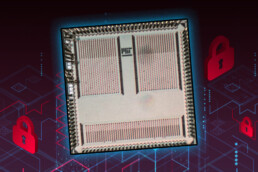Stronger security for smart devices
Stronger security for smart devices
Researchers demonstrate two security methods that efficiently protect analog-to-digital converters from powerful attacks that aim to steal user data.
Adam Zewe | MIT News Office
Researchers are pushing to outpace hackers and develop stronger protections that keep data safe from malicious agents who would steal information by eavesdropping on smart devices.
Much of the work done to prevent these “side-channel attacks” has focused on the vulnerability of digital processors. For instance, hackers can measure the electric current drawn by a smartwatch’s processor and use it to reconstruct secret data being processed, such as a password.
Recently, MIT researchers published a paper in the IEEE Journal of Solid-State Circuits, which demonstrated that analog-to-digital converters in smart devices, which encode real-world signals from sensors into digital values that can be processed computationally, are susceptible to power side-channel attacks. A hacker could measure the power supply current of the analog-to-digital converter and use machine learning to accurately reconstruct output data.
New program bolsters innovation in next-generation artificial intelligence hardware
New program bolsters innovation in next-generation artificial intelligence hardware
MIT AI Hardware Program launches with five inaugural companies to advance AI technologies for the next decade.
The MIT AI Hardware Program is a new academia and industry collaboration aimed at defining and developing translational technologies in hardware and software for the AI and quantum age. A collaboration between the MIT School of Engineering and MIT Schwarzman College of Computing, involving the Microsystems Technologies Laboratories and programs and units in the college, the cross-disciplinary effort aims to innovate technologies that will deliver enhanced energy efficiency systems for cloud and edge computing.
“A sharp focus on AI hardware manufacturing, research, and design is critical to meet the demands of the world’s evolving devices, architectures, and systems,” says Anantha Chandrakasan, dean of the MIT School of Engineering and Vannevar Bush Professor of Electrical Engineering and Computer Science. “Knowledge-sharing between industry and academia is imperative to the future of high-performance computing.”
Toward a stronger defense of personal data
Engineers build a lower-energy chip that can prevent hackers from extracting hidden information from a smart device.
A heart attack patient, recently discharged from the hospital, is using a smartwatch to help monitor his electrocardiogram signals. The smartwatch may seem secure, but the neural network processing that health information is using private data that could still be stolen by a malicious agent through a side-channel attack.
A side-channel attack seeks to gather secret information by indirectly exploiting a system or its hardware. In one type of side-channel attack, a savvy hacker could monitor fluctuations in the device’s power consumption while the neural network is operating to extract protected information that “leaks” out of the device.
“In the movies, when people want to open locked safes, they listen to the clicks of the lock as they turn it. That reveals that probably turning the lock in this direction will help them proceed further. That is what a side-channel attack is. It is just exploiting unintended information and using it to predict what is going on inside the device,” says Saurav Maji, a graduate student in MIT’s Department of Electrical Engineering and Computer Science (EECS) and lead author of a paper that tackles this issue.
Chip photo courtesy of the researchers


